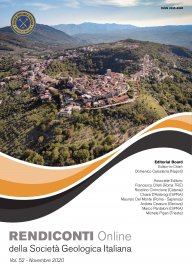
The dolines of Campoli Appennino (Frosinone, Italy): a geo-historical overview
Angelo Cipriani (1) & Scilla Roncacè (1)
(1) Dipartimento di Scienze della Terra, "Sapienza" Università di Roma.
Corresponding author e-mail: angelo.cipriani1985@gmail.com angelo.cipriani@hotmail.it
Volume: 52/2020
Pages: 77-102
Abstract
The spectacular karst morphologies of the area between Campoli Appennino and Alvito (Southern Lazio, Italy) represent an emblematic example of karst processes acting on different types of substrate. Hypogean forms are subordinated to epigean ones, with dolines as undiscussed leaders. Imposing and famous are the dolines of “Fossa Maiura” (also known as “Fossa Majura” or Fossa Majora”“) and “Il Tomolo”, around which the town of Campoli Appennino is built in a semi-circle, but are 8 the karst depressions with a diameter greater than 200 m (“main macrodolines”) in this area. These forms of landscape controlled the cultural and socio-economic aspects of this corner of Ciociaria. Starting from the second half of the 19th century, the hydrogeological, structural, stratigraphic and geomorphological features of the Campoli Appennino area, attracted the interest of geologists, allowing to recognize a “site of geological memory”. However, the geological heritage of this area worth greater visibility, as indicated by the poorly-developed geo-tourism, and for a greater dissemination, making the geo-morphological features more accessible and understandable, even for non-geologists.
Keywords
karst, dolines, Central Apennines, Meso-Cenozoic limestones, conglomerati di Campoli Appennino, History of Geology.
Get Full Text